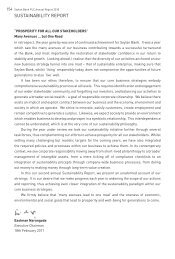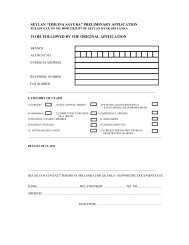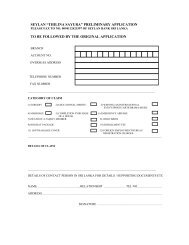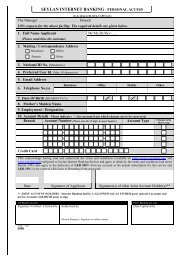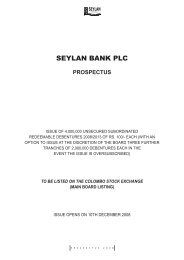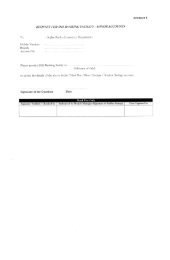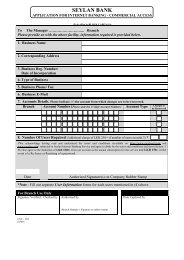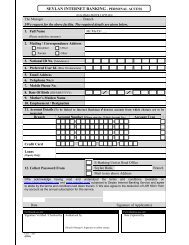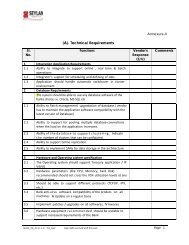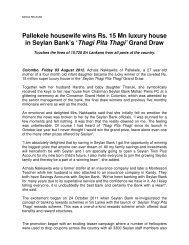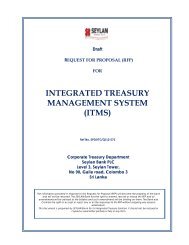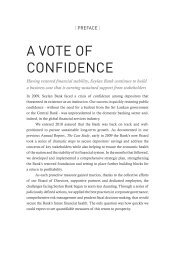Notes to the Consolidated Financial Statements - Seylan Bank
Notes to the Consolidated Financial Statements - Seylan Bank
Notes to the Consolidated Financial Statements - Seylan Bank
Create successful ePaper yourself
Turn your PDF publications into a flip-book with our unique Google optimized e-Paper software.
North Bound > <strong>Seylan</strong> <strong>Bank</strong> Annual Report 2011<br />
289<br />
(e) Market Risk<br />
Market risk is <strong>the</strong> risk that changes in market prices, such as interest rates, equity prices, foreign exchange<br />
rates and credit spreads (not relating <strong>to</strong> changes in <strong>the</strong> obligor’s/issuer’s credit standing) will affect <strong>the</strong><br />
<strong>Bank</strong>’s income or <strong>the</strong> value of its holdings of financial instruments. The objective of market risk management<br />
is <strong>to</strong> manage and control market risk exposures within acceptable parameters, while optimising <strong>the</strong> trading<br />
portfolios for risk management purposes. Overall authority for market risk is vested in ALCO.<br />
Market risk is <strong>the</strong> risk arising from fluctuations in <strong>the</strong> market price/value of tradable assets such as<br />
foreign exchange, fixed income securities and shares that are held for trading purposes where <strong>the</strong> <strong>Bank</strong><br />
holds ei<strong>the</strong>r long positions or short positions of such assets.<br />
The two risk components of <strong>the</strong> market risk most applicable <strong>to</strong> <strong>the</strong> <strong>Bank</strong> are foreign exchange risk and<br />
interest rate risk.<br />
(e i) The Foreign Exchange Risk arises from <strong>the</strong> foreign exchange positions maintained by <strong>the</strong> <strong>Bank</strong> where<br />
ei<strong>the</strong>r <strong>the</strong> foreign currency denominated assets exceed such liabilities (long positions) or <strong>the</strong> foreign<br />
currency denominated liabilities exceed <strong>the</strong> assets (short positions). Such long or short positions could also<br />
be created through <strong>the</strong> sale or purchase transactions both in spot and forward markets as well as through<br />
swap transactions. The <strong>Bank</strong> is conservative and prudent in its management of foreign exchange exposures<br />
and has set out limits on its transactions and exposures including dealer limits, portfolio limits, daylight<br />
limits, overnight limits, long position limits, short position limits, counterparty limits, etc.<br />
(e ii) Interest Rate Risk arises from <strong>the</strong> movement of interest rates affecting <strong>the</strong> value of tradable fixed<br />
income securities as well as <strong>the</strong> interest rate re-pricing gaps of <strong>the</strong> interest rate sensitive assets and<br />
liabilities. The <strong>Bank</strong> evaluates <strong>the</strong> risk level of <strong>the</strong> tradable fixed income securities portfolio by assessing<br />
<strong>the</strong> sensitivity of <strong>the</strong> market value <strong>to</strong>wards a change of interest rates by one hundred basis points, which<br />
is one percentage point. The size and duration of <strong>the</strong> trading portfolio is capped, based on <strong>the</strong> potential<br />
risk exposure as well as <strong>the</strong> Board approved limits placed on absolute values. <strong>Bank</strong>s also typically have<br />
mismatches in <strong>the</strong> re-pricing periods of assets and liabilities and an approach of minimising <strong>the</strong> gaps and<br />
limiting long-term fixed rates is followed by <strong>the</strong> <strong>Bank</strong>.<br />
<strong>Seylan</strong> as a policy does not carry a significant exposure <strong>to</strong> <strong>the</strong> equity market whilst of course being an<br />
active inves<strong>to</strong>r within applicable prudential limits.<br />
The different types of market risks and <strong>the</strong> Balance Sheet structure with a long-term focus are moni<strong>to</strong>red<br />
by <strong>the</strong> Asset and Liability Management Committee (ALCO).<br />
(f) Operational Risk<br />
Operational risk refers <strong>to</strong> <strong>the</strong> losses arising from fraud, negligence, oversight, human error, process<br />
errors, system failures, external events, etc. The <strong>Bank</strong> manages most elements of <strong>the</strong> operational risk<br />
through sound internal control systems and well defined processes both technology driven and with human<br />
intervention.<br />
The areas of risk include process risks where faulty processes or errors in <strong>the</strong> processes could trigger<br />
losses. Continuous review of <strong>the</strong> systems and <strong>the</strong> processes ei<strong>the</strong>r on a regular review basis or pursuant <strong>to</strong><br />
observed loss events and incidents addresses potential weaknesses of <strong>the</strong> processes.



